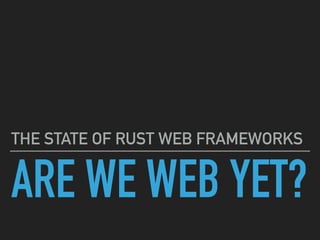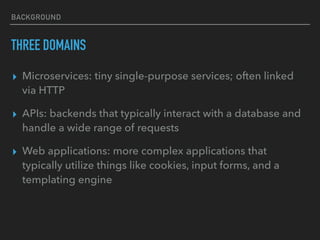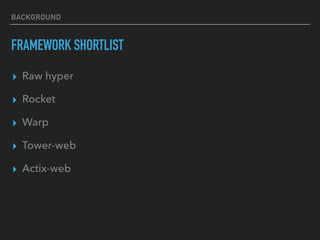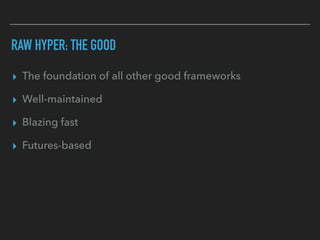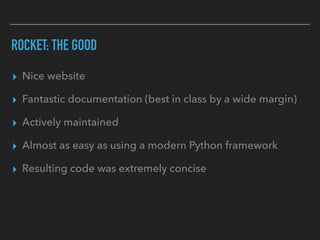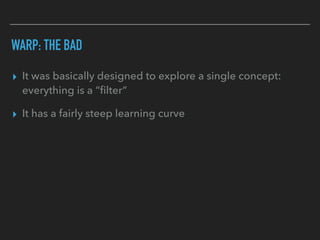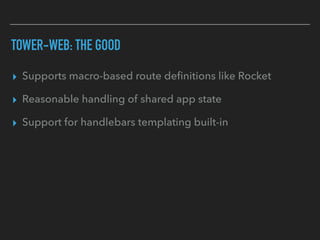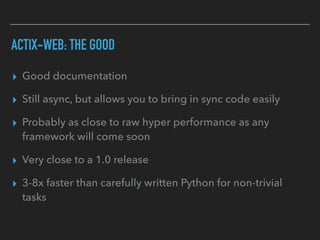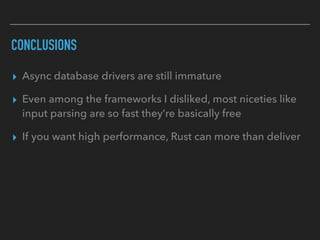The State of Rust Web Frameworks
- 1. ARE WE WEB YET? THE STATE OF RUST WEB FRAMEWORKS
- 2. BACKGROUND THREE DOMAINS Ō¢Ė Microservices: tiny single-purpose services; often linked via HTTP Ō¢Ė APIs: backends that typically interact with a database and handle a wide range of requests Ō¢Ė Web applications: more complex applications that typically utilize things like cookies, input forms, and a templating engine
- 3. BACKGROUND CHALLENGES Ō¢Ė Way too many framework choices Ō¢Ė Database libraries still donŌĆÖt support async that well Ō¢Ė Few blog posts etc. talking about real production usage Ō¢Ė Lack of adoption means that best practices havenŌĆÖt really emerged in many areas (DB connection pooling, for example)
- 4. BACKGROUND FRAMEWORK SHORTLIST Ō¢Ė Raw hyper Ō¢Ė Rocket Ō¢Ė Warp Ō¢Ė Tower-web Ō¢Ė Actix-web
- 5. BACKGROUND FRAMEWORK EVALUATION CRITERIA Ō¢Ė State of maintenance Ō¢Ė Ease of use Ō¢Ė Performance Ō¢Ė Feature set
- 6. RAW HYPER: THE GOOD Ō¢Ė The foundation of all other good frameworks Ō¢Ė Well-maintained Ō¢Ė Blazing fast Ō¢Ė Futures-based
- 7. RAW HYPER: THE BAD Ō¢Ė Not really a framework so expect to write lots of boilerplate Ō¢Ė Learning curve Ō¢Ė Futures-based
- 8. ROCKET: THE GOOD Ō¢Ė Nice website Ō¢Ė Fantastic documentation (best in class by a wide margin) Ō¢Ė Actively maintained Ō¢Ė Almost as easy as using a modern Python framework Ō¢Ė Resulting code was extremely concise
- 9. ROCKET: THE BAD Ō¢Ė Seems to be largely controlled by a single maintainer who dictates the release cycle Ō¢Ė Built on outdated dependencies (most notably hyper) Ō¢Ė Performance was anything but rocket-like. Terrible stability under heavy load; save yourself the headache and just use Python
- 10. WARP: THE GOOD Ō¢Ė ItŌĆÖs fast Ō¢Ė ItŌĆÖs small
- 11. WARP: THE BAD Ō¢Ė It was basically designed to explore a single concept: everything is a ŌĆ£’¼ülterŌĆØ Ō¢Ė It has a fairly steep learning curve
- 12. TOWER-WEB: THE GOOD Ō¢Ė Supports macro-based route de’¼ünitions like Rocket Ō¢Ė Reasonable handling of shared app state Ō¢Ė Support for handlebars templating built-in
- 13. TOWER-WEB: THE BAD Ō¢Ė Lacks many basic features like query string binding during the request ’¼éow Ō¢Ė Parsing capabilities it does have are terribly handicapped (example: not supporting ’¼éoating point values) Ō¢Ė Requires some weird macro wrapping stuff around your application struct
- 14. ACTIX-WEB: THE GOOD Ō¢Ė Good documentation Ō¢Ė Still async, but allows you to bring in sync code easily Ō¢Ė Probably as close to raw hyper performance as any framework will come soon Ō¢Ė Very close to a 1.0 release Ō¢Ė 3-8x faster than carefully written Python for non-trivial tasks
- 15. ACTIX-WEB: THE BAD Ō¢Ė Much more verbose than IŌĆÖd like Ō¢Ė Taking a paradigm designed for one language and porting it to another seems odd to me, but they did a great job Ō¢Ė Databases seem to be somewhat an afterthought, and the examples donŌĆÖt really show the proper way to do things
- 16. CONCLUSIONS Ō¢Ė Most frameworks are pretty immature and donŌĆÖt seem to see serious production use Ō¢Ė Not enough attention is paid to developer ergonomics Ō¢Ė Rust is a viable choice for APIs and microservices where high performance is critical, but be prepared to put in a lot of upfront work for a larger web app Ō¢Ė Futures/async will probably be the thing that trips you up the most, but actix makes things tolerable
- 17. CONCLUSIONS Ō¢Ė Async database drivers are still immature Ō¢Ė Even among the frameworks I disliked, most niceties like input parsing are so fast theyŌĆÖre basically free Ō¢Ė If you want high performance, Rust can more than deliver
- 18. OBLIGATORY REQ/SEC BENCHMARK (AVG. OF 3 RUNS ON MY MACBOOK) 1 10 100 1K 10K 100K HELLO POSTGIS 2.18K 79.12K 2.31K 62.8K 2.2K 56.27K 1.21K 10.18K 542549 rocket aiohttp tower warp actix $ cargo run --releaseŌĆ© $ wrk -t20 -c500 -d30s
